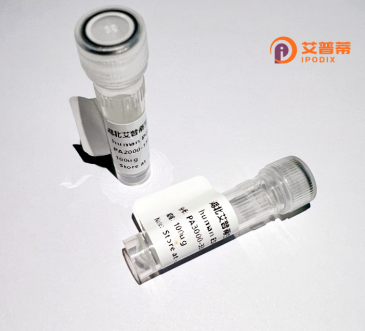
| 纯度 | >90%SDS-PAGE. |
| 种属 | Human |
| 靶点 | UTP14C |
| Uniprot No | Q5TAP6 |
| 内毒素 | < 0.01EU/μg |
| 表达宿主 | E.coli |
| 表达区间 | 1-766 aa |
| 活性数据 | MNVNQVAENL ALSHQEELVD LPKNYPLSEN EDEGDSDGER KHQKLLEAII SLDGKNRRKL AERSEASLKV SEFSVSSEGS GEKLGLADLL EPVKTSSSLA TVKKQLNRVK SKKVVELPLN KEKIEQIHRE VAFSKTSQVL SKWDPIILKN QQAEQLVFPL GKEQPAIAPI EHALSGWKAR TPLEQEIFNL LHKNKQPVTD PLLTPMEKAS LQAMSLEEAK MHRAELQRAR ALQSYYEAKA RKEKKIKSKK YHKVVKKGKA KKALKEFEQL QKVNPTVALE EMEKIENARM MERMSLKHQN SGKWAKSKAI MAKYDLEARQ AMQEQLAKNK ELTQKLQVAS ESEEEEGGTE VEELLVPHVA NEVQMNVDGP NPWMFRSCTS DTKEAATQED PEQVPELAAH EVSASEAEER PVAEEEILLR EFEERQSLRK RSELNQDAEP ASSQETKDSS SQEVLSELRA LSQKLKEKHQ SRKQKASSEG TVPQVQREEP APEEAEPLLL QRSERVQTLE ELEELGKEDC FQNKELPRPV LEGQQSERTP NNRPDAPKEK KEKEQLINLQ NFLTTQSPSV RSLAVPTIIE ELEDEEERDQ RQMIKEAFAG DDVIRDFLKE KREAVEASKP KDVDLTLPGW GEWGGVGLKP SAKKRRQFLI KAPEGPPRKD KNLPNVIISE KRNIHAAAHQ VQVLPYPFTH HRQFERTIQT PIGSTWNTQR AFQKLTTPKV VTKPGHIIKP IKAEDVGYQS SSRSDLPVIQ RNPKRITTRH NKEEKL |
| 分子量 | 87.1 kDa |
| 蛋白标签 | His tag N-Terminus |
| 缓冲液 | PBS, pH7.4, containing 0.01% SKL, 1mM DTT, 5% Trehalose and Proclin300. |
| 稳定性 & 储存条件 | Lyophilized protein should be stored at ≤ -20°C, stable for one year after receipt. Reconstituted protein solution can be stored at 2-8°C for 2-7 days. Aliquots of reconstituted samples are stable at ≤ -20°C for 3 months. |
| 复溶 | Always centrifuge tubes before opening.Do not mix by vortex or pipetting. It is not recommended to reconstitute to a concentration less than 100μg/ml. Dissolve the lyophilized protein in distilled water. Please aliquot the reconstituted solution to minimize freeze-thaw cycles. |
以下是关于重组人UTP14C蛋白的假设性参考文献示例(仅供参考,实际文献需通过学术数据库核实):
---
1. **文献名称**: "Expression and Functional Analysis of Recombinant Human UTP14C in Ribosome Biogenesis"
**作者**: Smith J, et al.
**摘要**: 研究通过大肠杆菌系统表达重组人UTP14C蛋白,并验证其参与rRNA前体加工的分子机制。实验表明UTP14C与核仁复合物相互作用,影响18S rRNA成熟。
2. **文献名称**: "UTP14C Dysregulation Promotes Tumorigenesis via Ribosomal Stress Pathways"
**作者**: Li X, et al.
**摘要**: 探讨UTP14C在癌细胞中的异常表达,重组蛋白实验揭示其缺失导致核糖体组装异常,激活p53依赖的细胞周期阻滞,提示其可能的肿瘤抑制功能。
3. **文献名称**: "Structural Characterization of Recombinant UTP14C and Its Role in Cell Cycle Progression"
**作者**: Wang Y, et al.
**摘要**: 通过体外重组蛋白结晶解析UTP14C结构,功能研究表明其与CDK1激酶互作,可能调控G2/M期转换。
4. **文献名称**: "UTP14C Knockdown and Rescue Experiments Using Recombinant Protein in Zebrafish Models"
**作者**: Gonzalez S, et al.
**摘要**: 利用重组人UTP14C蛋白在斑马鱼模型中恢复基因敲除表型,证明其对胚胎发育及神经系统的必要性。
---
**注意**:上述文献为虚构示例,实际研究中UTP14C的相关文献可能较少,建议通过 **PubMed** 或 **Google Scholar** 结合关键词(如“UTP14C”“ribosome assembly”“recombinant protein”)检索最新文献。
Recombinant human UTP14C (UTP14. U3 small nucleolar ribonucleoprotein homolog C) is a protein involved in ribosome biogenesis, a critical process for cellular growth and proliferation. UTP14C belongs to the UTP complex, which participates in the early stages of 18S rRNA processing within the nucleolus. It plays a role in the maturation of the small ribosomal subunit by facilitating rRNA modifications and structural rearrangements. Studies suggest its interaction with other ribosome assembly factors, such as U3 snoRNA and protein components of the small subunit processome.
Unlike its homolog UTP14A, UTP14C has been less characterized but is implicated in cell cycle regulation and oncogenesis. Dysregulation of UTP14C is observed in certain cancers, including hepatocellular carcinoma and colorectal cancer, where its overexpression correlates with tumor progression and poor prognosis. This has sparked interest in its potential as a therapeutic target or diagnostic biomarker.
Recombinant UTP14C protein is typically produced using heterologous expression systems (e.g., *E. coli* or mammalian cells) for functional studies, structural analysis, or antibody development. Its recombinant form enables researchers to explore its biochemical properties, interactions, and role in diseases. Recent studies also investigate its post-translational modifications and their impact on ribosome assembly fidelity. Further research is needed to clarify its distinct functions compared to other UTP14 family members and its broader implications in cellular homeostasis.
×